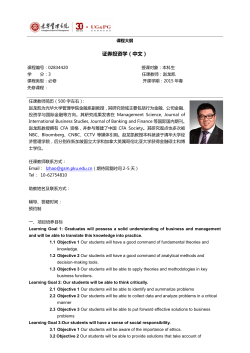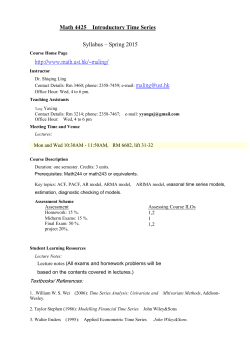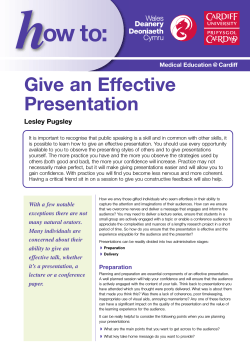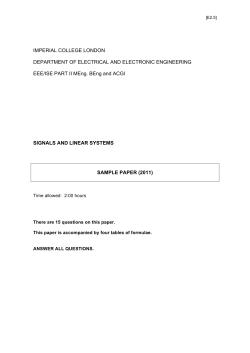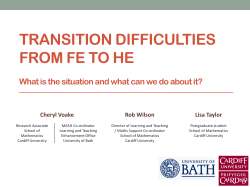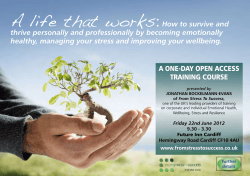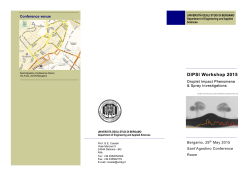
h ow to: Spice-up Your Lectures Stephen Brigley
h ow to: Medical Education @ Cardiff Spice-up Your Lectures Stephen Brigley Both lectures and large group teaching sessions have a long history as modes of delivery of medical education. Despite the introduction of a variety of different teaching techniques over time, small group and self-directed learning and the opportunities provided with the development of web technologies, the oral transmission model remains an educational stalwart. Indeed the increasing expansion of medical schools makes this an ever appropriate and effective approach. Plenary sessions can provide opportunities for learners to have access to the latest evidence and to witness role modelling of professional skills and values from their seniors. However lectures also have the potential to focus on examination specific topics or simply allow for the regurgitation of material readily available in other formats. In order to ensure that learners are engaged and lecturers are energised, it is vital to ensure that we deliver interactive and creative sessions that can aid understanding and so promote learning. What are the skills of a lecturer? Before looking at how to improve lectures, you should be clear on the difference between a lecture and a presentation. Presentation of information is only one skill a lecturer needs. There are many more . . . However as Bligh (2000) notes, it is important to remember that most lectures will be assessed at both extremes of a general rating scale. A lecturer will do well if they please more than half the audience. Q Preparation Sequencing and structuring lectures Q Explaining If the lecture is seen as particular type of teaching session, when planning a lecture you should keep in mind common bases for the sequencing and structuring of teaching, for example, by defining educational aims and outcomes and planning around Gagne’s instructional events: Q Openings Q Narrating Q Comparing & contrasting Q Designing & using audio-visual aids Q Responsiveness to audience Q Varying student activity Q Summarising (Brown & Manogue, 2001) We also expect a good lecturer to show a level of enthusiasm and motivational skill. Thus, nowadays the lecture equates not only to the reading of a text (lectare = to read), it is a format for large group teaching which opens up a range of possibilities you may wish to try out.. Q Gain attention Q Inform learner of objectives Q Stimulate recall Q Present stimulus material Q Provide learner guidance Q Elicit performance Q Provide feedback Q Assess performance Q Enhance retention However, accepted approaches may need to be adapted to various purposes that a lecture may exemplify and related structures, namely: Q Classical - the topic is logically divided and the same approach applied to sub-topics Q Problem-centred– the problem is outlined and solutions explained Q Sequential – a chain of reasoning is applied to a topic or process, leading to a conclusion Q Comparative – different views of a topic are compared Q Thesis – arguments are presented for or against a particular assertion You may already have had experience of some of these variations. If not, useful illustrations of the first three are provided in Brown & Manogue (2001, pp 233-4). A comparative lecture such as ‘The causes and clinical management of HIV & AIDS in developed and developing countries’ would require clear definition of the points of comparison. An example of a thesis-type lecture would be: ‘The case for making the MMR vaccine compulsory’. Making lectures interactive Much recent attention has been devoted to how to transform lectures into interactive learning experiences. Some ideas to consider are: Q Alter the environment – move around and get closer to the audience; change seating arrangement to a horseshoe (easier when seats are not fixed and numbers are smaller). Q Ask questions to stimulate and check understanding – but make sure the questions are open, non-threatening and reasonably straightforward Q Set up structured in-class discussions - snowball, brainstorm and buzz group activities are viable in some lecture environments Q Add quizzes, questionnaires, review points – but make sure they are structured in and serve a learning outcome. Q Introduce cases (paper, video or real patients) - for illustration, question and answer, discussion and problem-solving activities Q Set up debates, panels, role play and simulation – these require special preparation and organisation but are often very worthwhile. Q Show clips from DVD or videos, and audio-visual aids - to illustrate, trigger thinking and prompt questioning and discussion. Modern technologies such as electronic response systems allow the audience to respond to a lecture in a way that adds immediacy and enjoyment. The audience is set questions to vote on, using electronic handsets. Their responses are aggregated and displayed immediately on a screen. Use of this response equipment helps to overcome two major problems faced by lecturers: audience passivity and lack of feedback on how well the audience has understood the lecture. Other uses of audience response systems include: learner assessment (formative and summative); evaluation of teaching; peer assessment; profiling of the audience; trying out ideas and experiments with audience; and to set up discussions. Evidence of their effectiveness has been put forward in Draper & Brown (2004). Interactive handouts Many of the above interactive strategies can be complemented by handouts that not only provide a record of the lecture content but also engage the learners in activities. An increasingly common approach is that of guided note-taking. Here the handout consists of a skeleton in which key facts, concepts and principles are provided, along with adjacent spaces to write in. By giving them responsibility for selection of information and conceptual organisation, learners can customise lecture notes in a way that is more accessible to them later. Note-taking should be facilitated by allowing time in the lecture for the audience to review, ask questions and raise points of clarification. Interactive handouts can also include pictures, diagrams, photos and key messages to give a focus for audience response at certain stages, as well as suggestions on further resources and opportunities for learning. Exercise In order to practice your approach to lecturing, choose a noun, at random, from the dictionary and plan a one-minute lecture on that topic. What do you notice about the selection and structuring of content? Are visual aids still used? Is interaction with the audience possible? This can also be a helpful exercise for use in a small CPD group to allow participants to practice their lecturing skills and also their feedback techniques with peers by undertaking peer review. Conclusion There is more scope than ever to make the lecture interactive, but ultimately you have to respect its fundamental purposes which lie in explaining the essentials of a topic and providing a structure to further learning. Further Information Bligh D. (2000) What’s the Use of Lectures? Jossey-Bass: San Francisco Brown G. Manogue M. (2001) Refreshing lecturing, AMEE Guide No. 22. Draper S. Brown M. (2004) Increasing interactivity in lectures, Journal of Computer Assisted Learning 20: 81-94 Huxham M. (2005) Learning in lectures: Do interactive windows help? Active Learning in Higher Education 6: 17-31 Morton A. (2009) Lecturing to large groups, in Fry H. et al. (eds.) Handbook for Teaching and Learning in Higher Education Dornan, T. Ellaway, R. (2011). Teaching and Learning in large groups: lecturing in the twenty first century. In T. Dornan, K. Mann, A. Scherpbier, J. Spencer (2011). Medical Education: Theory and Practice. Edinburgh: Elsevier. Stephen Brigley was a Senior Lecturer in Medical Education in the School of Postgraduate Medical and Dental Education, Cardiff University. Interested in learning more about this and other educational topics? Why not professionalise your role with an academic qualification at PGCert, Dip or MSc in Medical Education via e-learning or attendance courses. Contact: medicaleducation@cardiff.ac.uk Series Editor: Dr Lesley Pugsley, Medical Education, School of Postgraduate Medical and Dental Education, Cardiff University. Wales Deanery Cardiff University, 9th Floor, Neuadd Meirionydd, Heath Park, Cardiff CF14 4YS Tel: +44 (0)29 2068 7451 Fax: +44 (0)29 2068 7455 E-mail: medicaleducation@cardiff.ac.uk ISBN: 978-1-907019-30-2
© Copyright 2025

